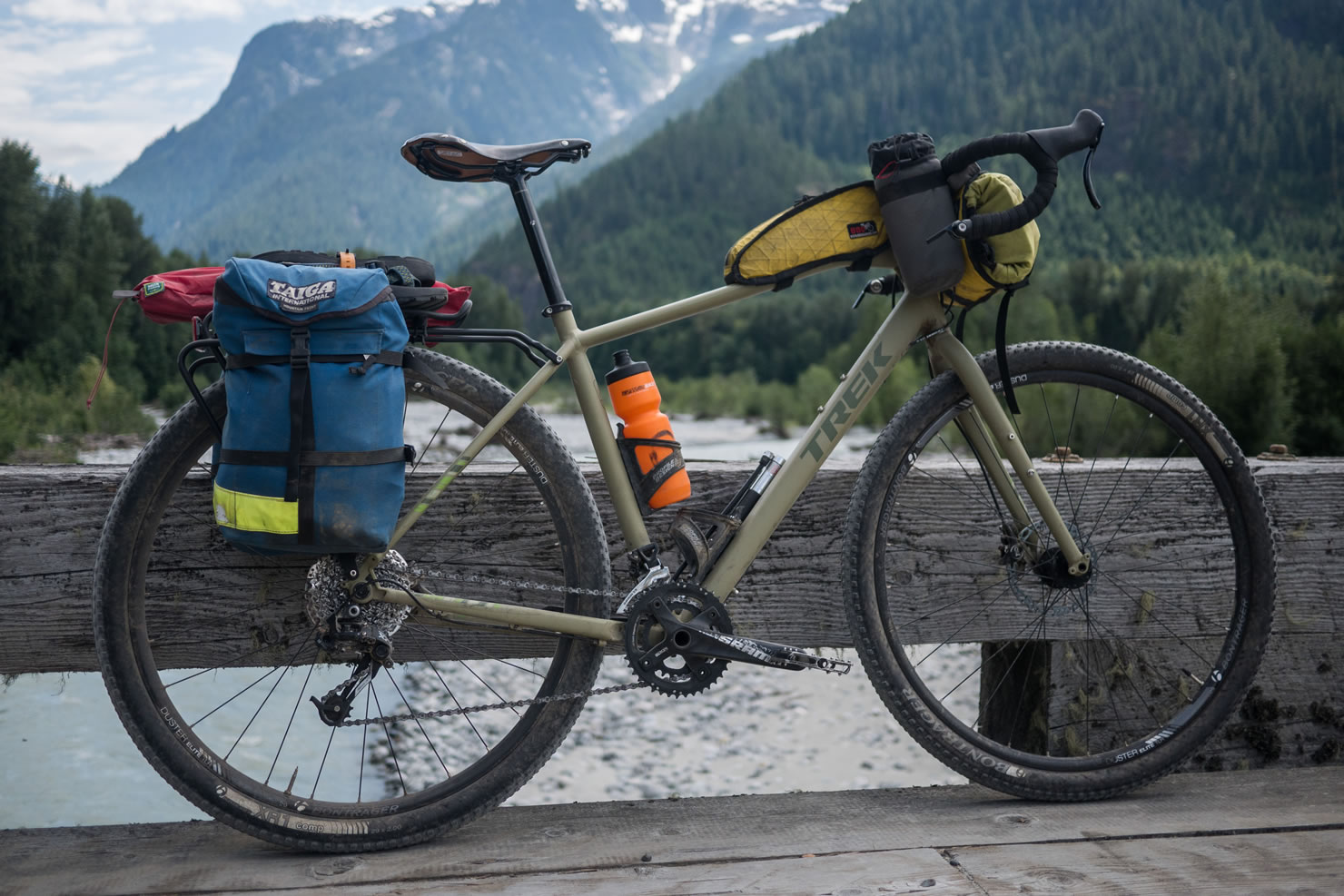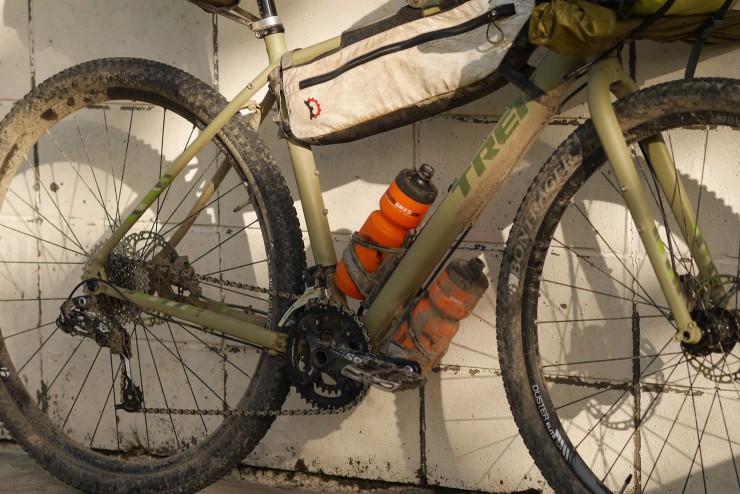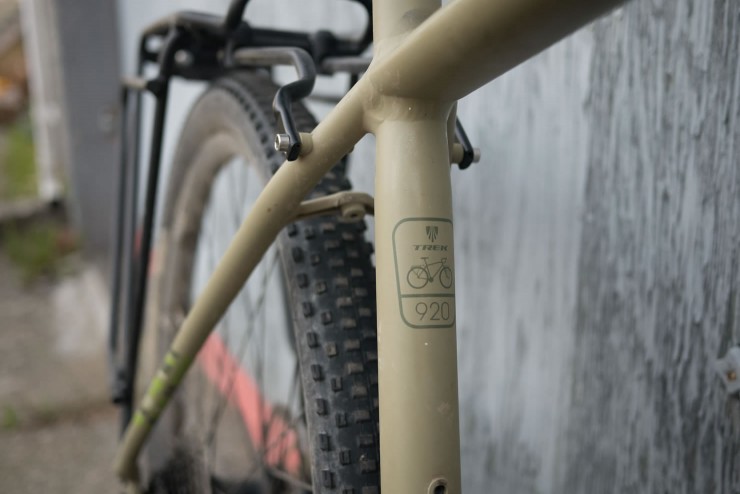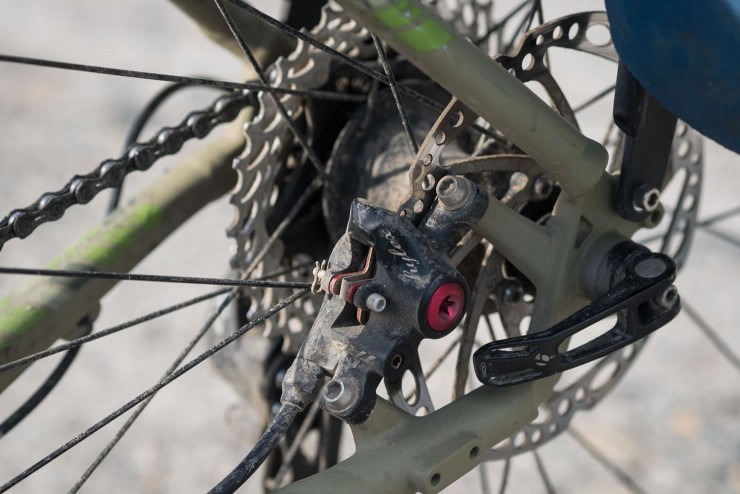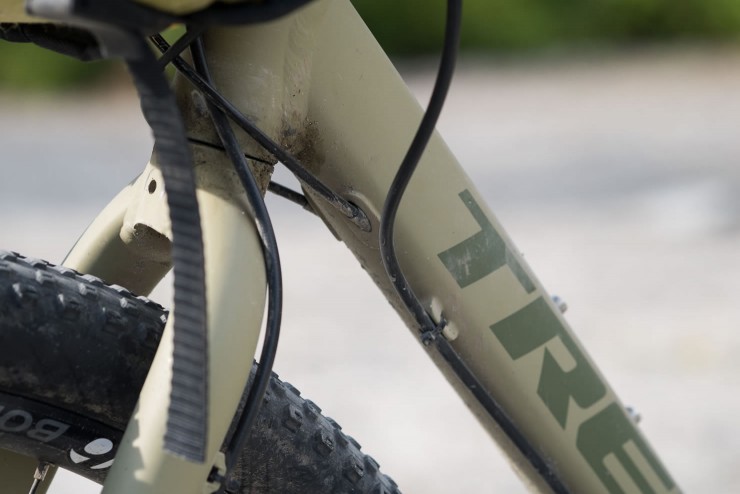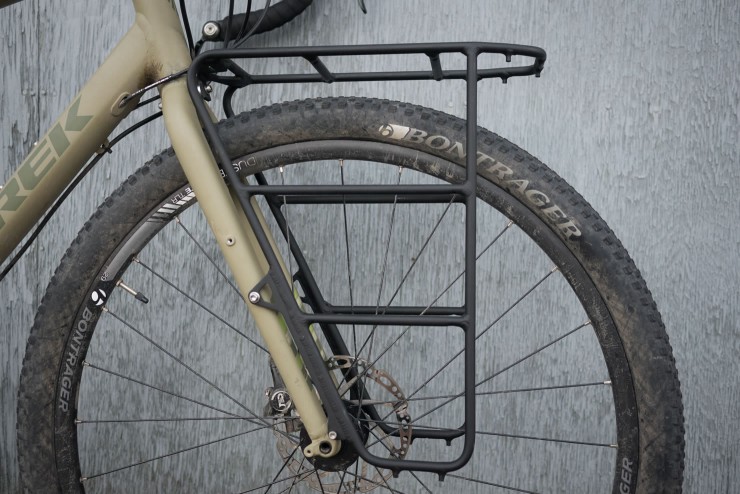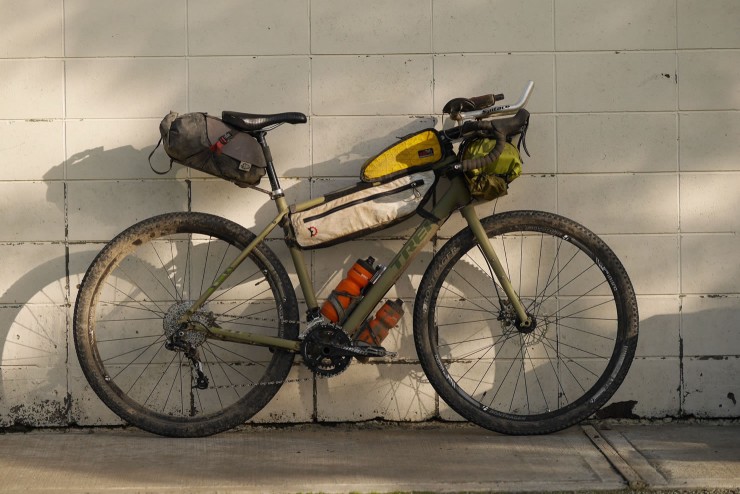Trek 920 Review: What’s an adventure bike?
Joining the ever-burgeoning ranks of the ‘adventure bike’, Trek’s 920 aims to rewrite the classic touring rulebook. For a start, it uses a lightweight aluminum frame, the latest in industry thru-axle standards, and sports clearances for 2.2in 29er tires. There’s custom racks and provision for 6 water bottles too. But does this mean it can really go where no touring bike has previously been? Skyler Des Roches takes one to British Colombia to find out…
It’s clear on paper that the Trek 920 is a category-confused bike. Is it a drop-bar 29er? A touring bike? A monster-cross or all-road thing? Several companies are calling similar machines “adventure bicycles”. What does that even mean? How does the curious mating of spec and geometry often found in this newly-minted category play out on planet Earth?
While I’ll concede that I don’t think it really matters what particular narrow niche a bike is labeled under, I do think that knowing what a bike does best is extremely useful when shopping. In a world where the word adventure has been appropriated by urban dog-walkers and picnickers, my challenge in reviewing Trek’s answer to the “adventure bike” was to figure out what the hell this bike was for.
From afar, the Trek 920 looks a lot like many of this year’s new breed of gravel or randonneur bikes. But, those bikes are adapted cyclocross or road designs and can usually fit 700x40c tires or more voluminous, but smaller diameter 27.5×2.1” (650Bx53) mountain bike tires. The 920 comes set up with Bontrager Duster Elite 29er wheels, and clearance for up to about 29×2.25” (untested, so this might depend on the tire). Running the stock Bontrager XR1 tires, which measure 29×2.0” (or 700Cx51 if you prefer), there is even space for fenders.
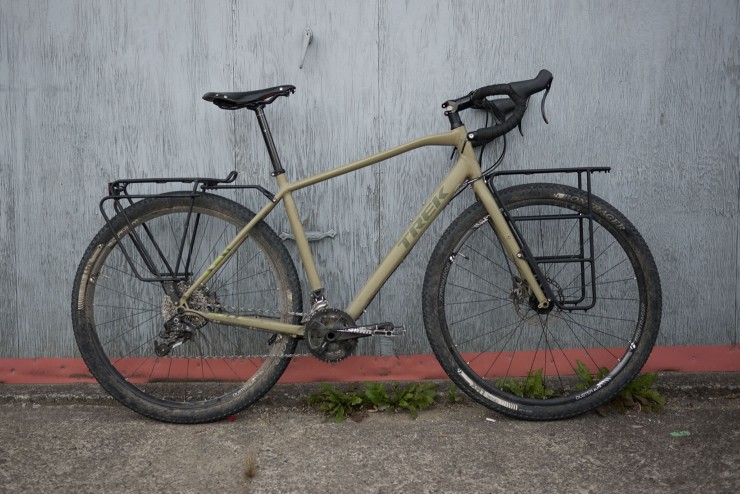
One upside to the bike industry’s new love for the word “adventure” is that it has provided an opportunity for bike manufacturers to break some of the old rules of touring bikes. Gone is the old singular meaning of adventure cycling, the one that meant loading up a small mountain of gear strapped to front and rear racks, just sort of suffering along whatever road, and praying that the equipment would hold up.
These days, adventure means, well, just about anything if you believe the marketing. It’s the hottest thing in cycling, and everyone wants a slice. Adventure biking is being used simultaneously as a category, and an all-encompassing activity. Full-suspension mountain bike – adventure; hardtail – definitely adventure; cross bike – whiskey and adventure; expensive road bike – hella adventurizing. The spirit of adventure never changed, but the old rule book – the one that required 26” wheels, Schwalbe solid rubber tires, rim brakes, drop bars, 36 spoke wheels, square-tapers, leather and steel – has been shown out the back door. It’s rather confusing from a marketing perspective, so it’s perhaps understandable that the 920 would appear so category-confused.
At its core, Trek’s 920 seems to aim to achieve the same thing as those rule-bound classic touring bikes, but freed the Luddite mentality that is becoming less and less necessary for international touring as bikes get more reliable, and a variety of parts more easily available around the world. Its aluminum frame features thru-axles, internal cable-routing, a bent top tube that allows three bottle cages within the front triangle on sizes 56cm and up, braze-ons for front and rear racks (which come included), and bottle cage mounts on each fork leg and below the down tube. That’s a total of six bottle mounts on the frame and fork. The aluminum material is exotic in itself for a touring bike, but it allows for a bike that weighs only 26lbs in size 58cm.
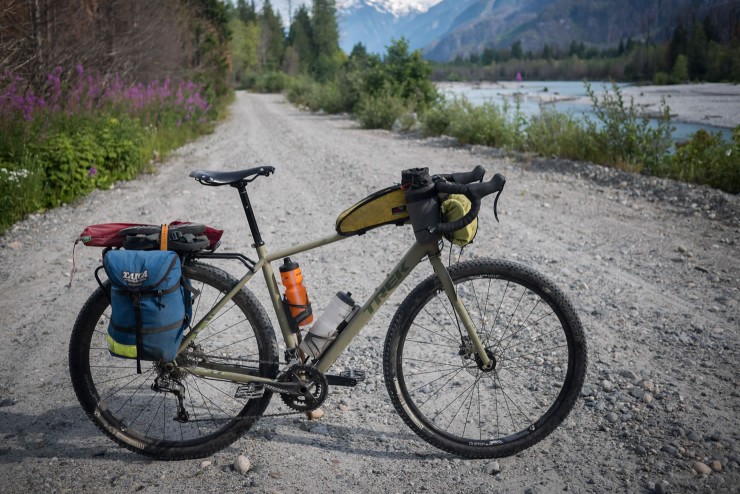
The Spec
Though a frame will always be the heart of a bike, I’d guess that the 920 is the sort of bike that will almost always be purchased and ridden as a complete package. As such, the stock parts spec will be important to most people looking at this bike.
The 920’s build, with a few exceptions, offers a build spec that will come as a breath of fresh air for cycle tourists: its components, for the most part, are exceedingly well-suited to the unique needs of pedaling a loaded bike. Namely, its mountain bike gearing, powerful brakes, decent tires, and strong racks will mean forgoing some common component swaps made to brand new touring bikes.
FRAMESET
- Frame 100 Series Alpha aluminum w/rack + fender mounts
- Fork Trek Adventure alloy disc, 15mm thru-axle
WHEELS
- Rims Bontrager Duster Elite Tubeless Ready
- Hubs 15mm front, 142×12 rear
- Tires Bontrager XR1, 29×2.0″
DRIVETRAIN
- Shifters SRAM 500 TT, bar end control, 10 speed
- Front derailleur SRAM X5
- Rear derailleur SRAM X7, Type 2
- Crank SRAM S1000, 42/28T
- Cassette SRAM PG-1030, 11-36, 10 speed
- Chain KMC X10
COMPONENTS
- Saddle Bontrager Evoke 1.5
- Seatpost Bontrager alloy, 2-bolt head, 27.2mm, 8mm offset
- Handlebar Bontrager Race, VR-C, 31.8mm
- Stem Bontrager Elite, 31.8mm, 7 degree, comes w/ computer & light mounts
- Headset FSA IS-3, 1-1/8″ threadless, sealed cartridge bearings
- Brakeset TRP Hylex hydraulic disc
A highlight reel
- Tubeless ready wheels with asymmetrical spokes (for more even spoke tension).
- Bontrager 29×2.0” XR1 Comp tires: cheap yes, but also pretty ideal for rolling efficiently on gravel and paved surfaces. I was able to run these tires tubeless for duration of the test, even if they’re not a tubeless ready tire.
- 2×10 Sram X7 mountain drivetrain: mountain bike drivetrain on a drop bar bike?! A 42/28 crankset?! Pinch me. This gear range is actually suitable for cycle touring.
- TRP Hylex hydraulic disc brakes: because being able to actually stop a loaded drop bar touring bike is something the world deserves. Unlike mechanical disc brakes, these are set-and-forget, requiring zero maintenance.
- Thru-axles: because if it’s going to have mountain bike wheels, it’d better be able to run common mountain bike wheels. They also surely add a degree of stiffness, stability, and strength to the frame when stressed by heavy loads.
- Custom racks: yup, the 920 comes with front and rear racks designed to mount specifially to this bike, and as far as I can tell, they’re bomber.
There were only a couple of parts that were immediately unimpressive. First, the saddle did not agree at all with my posterior. I guess that’s a matter of personal preference. Second, the stock stem lengths are atrociously out of whack with the bike’s geo. Consider that Specialized’s AWOL has very similar front end geometry, and specs a 70mm stem on the size L. The 58cm Trek reviewed here came with a 110mm fishing pole.
Now, I’m a relatively averagely proportioned 6’2” tall man. I’ve never come across a bike that was offered in 58cm where the correct size for me wasn’t 58cm. I don’t doubt that the stock stem length will work for some folks out there, but I’d have hoped Trek would aim for average. As it was, I immediately swapped to an 85mm stem, and would probably be happier with a 70mm.
Besides that, there are a few spec choices that don’t quite fit with the nature of the bike. They’re not huge detriments, but they add to the category confusion of the Trek 920.
I guess it’s not really fair to be puzzled at the bar-end shifters – I know why they’re there. Reason 1: this is a $2000 drop bar bike with hydraulic disc brakes. They’ve got to cut cost somewhere and bar-cons are a good way to do that. Reason 2: there’s an old notion that bar-end shifters are a good choice for touring. Part of this idea comes from a sort of retro-grouch mentality that says simple is inherently more durable. I disagree, but I’ll get to that. Part of the old appeal of bar-end shifting stems from the flexibility of friction shifting. Bent derailleurs or derailleur hangers can sometimes be limped home with some amount of shifting in friction mode. Alas, while Sram 10 speed allows the mixing of road shifters with mountain drivetrains, those Sram bar-cons cannot be switched to friction mode.
But given the wide tires, thru-axles, hydraulic disc brakes, aluminum frame and tubeless wheels, I’d think the 920 was beyond all that – a 21st century answer to the touring category. Rather than providing any sort of real advantage to reliability, the bar-end shifters just place thin aluminum shift levers in one of the most vulnerable places on a bicycle. If the bike falls over, which is likely to happen at some point if you use front panniers, there’s a real possibility of breaking or bending the shifter lever.
You and I can likely live with all that given the rest of the spec. The real annoyance came when I thought to myself “damn, this bike could almost pass as a real mountain bike. I should turn off on that singletrack right there.” Or maybe it was that all the underbiking I saw the last time I checked that well-known cycling fashion blog. You know, the one where they’re always riding absurdly expensive road bikes on California singletrack.
And even that started out great. It was a blast right up until the first short, punchy climb. I stood up on the pedals, spine curled and hands deep in the back of the drops when cluuunk…instant knee-to shifter contact. Gear 1 to 10 in one second flat. Game over, no more climbing. Those accidental knee-shifts all but prevented me from using this bike as a drop-bar mountain bike.
Given that those shifters and racks are good indicators that Trek may have intended the 920 to fill the role of a classic touring bike (while somewhat extending its utility onto unsealed surfaces) the 28-spoke wheels are also surprising. Sure, 28-spoke wheels are common for all manner of mountain biking these days, including such high wheel-abuse activities as enduro racing. The Bontrager Duster Elite wheelset is built using asymmetrical rims, which provide more even spoke tension, and may allow them to hold their own against higher spoke-count hoops. But, wheels are subject to a lot of abuse when riding corrugated roads with four bursting panniers, as might be expected on a 920. Fortunately, throughout the test, the Bontrager wheels showed no sign of struggling, though I never did ride the bike loaded with more than about 15kg.
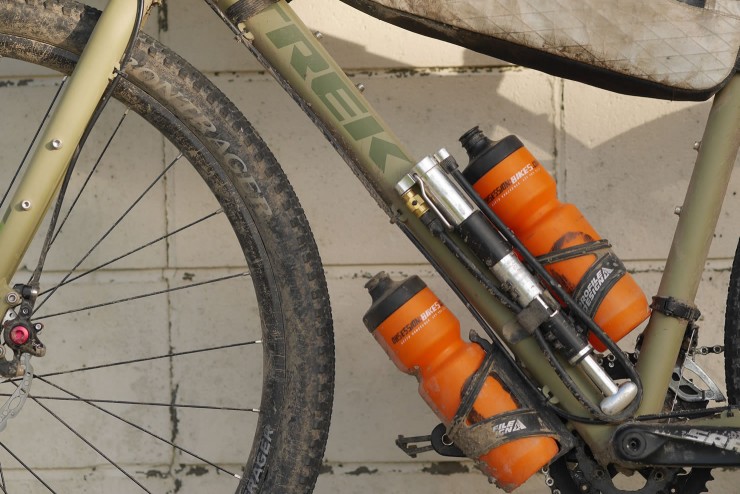
The Ride
With its long 465mm chain stays, its very low 85mm bottom bracket drop, and its high trail fork, the Trek 920 is built for stability above all. Combined with the large wheels, this has the down side of making the bike decidedly not nimble. This is, perhaps, its weakness. It is especially noticeable when the bike plays dual duty as a commuter. Even though my commute times were not noticeably slower than on my positively zippy little 90’s mountain bike-commuter conversion, the 920 felt very slow to accelerate, and far less eager to take 90 degree corners at speed. It made up for time, however, by easily cruising at speeds similar to a road bike.
With a front load, that high-trail fork exacerbates the lack of maneuverability, making it ride as if on rails. This is likely of benefit moving fast on open roads, but I’d advise against riding with a front load bias off-road. Note that, despite the recent resurgence of front loading – a style of touring long popular amongst randonneurs and their low trail bikes – the 920 and the likes of Specialized’s AWOL have very similar trail measurements, and are not actually any more suitable for front-loading off pavement than other bikes. Instead, I found the 920 handled best with a slight rearward weight bias, or close to even front-to-back weight distribution.
Loaded up on smooth back-roads, whether dirt or pavement, this stability plays to its favour. On one lightly-loaded two-night trip, I was able to maintain close to a 25km/h moving average on smooth gravel roads – much higher than my usual plodding pace. Once up to speed, I could sit in the drops and go, and go, and go…I rode 60km of dirt roads in falling snow for lunch with friends, and 60km back along sloppy mud roads in the rain. The next day, 80km before lunch. These are not my usual sorts of backroad riding days, I’m really not that fit.
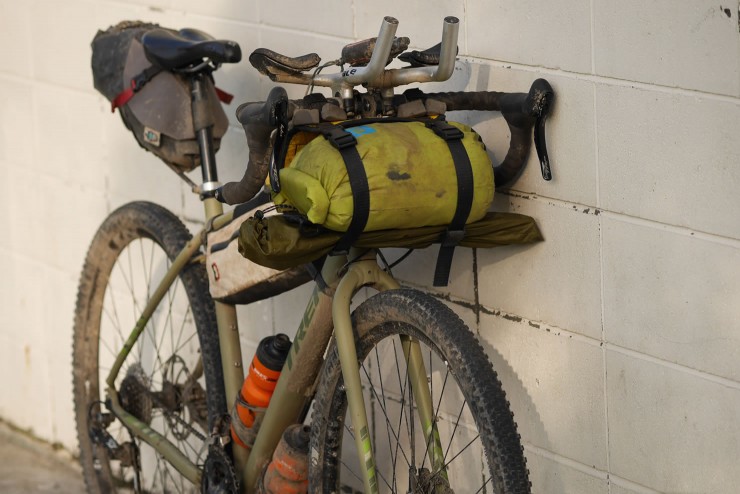
This efficiency is no doubt one of the few benefits of drop bar bikes for dirt road touring. I find the riding position (after the stem switch) generally more powerful, and less energy-consuming on the 920 than I’m used to. That said, this being a demo bike, I did not have the opportunity to cut the steerer tube to my preferred length. I found the drops often felt too low, while the hoods felt too high. On one trip, I added some aero bars. By rotating between the three riding positions – climb on the hoods, rotate between the drops and aero bars on flats, and descend in the drops – I was able stay comfortable enough.
On rougher roads, such as the crushed rock logging roads found in British Columbia’s more mountainous parts, the efficient road bike-like riding position and incredible stability (lack of maneuverability) ceased to be a benefit. Instead, I found the position made it challenging to effectively absorb rough stretches, even if the bike itself encouraged me to bomb through those parts. After 100km of that sort of road, my back was sore and I was wishing for a flat bar bike. I’m convinced that a flat bar rigid 29er remains the best option over the greatest variety of terrain, even if the drop bar 29ers excel on gravel roads.
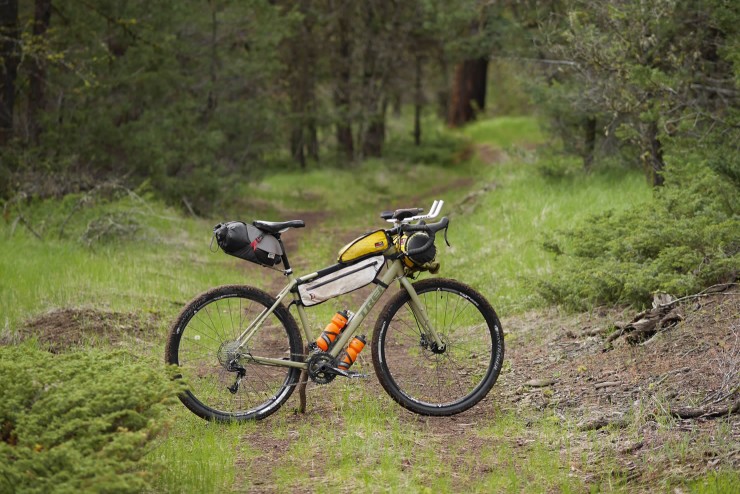
Furthermore, the low bottom bracket and bar-end shifters make it very challenging to ride the 920 on even relatively easy singletrack. Perhaps it’s because I’m used to riding modern hard tails on that sort of surface, but between the constant pedal-to-ground and knee-to-shifter strikes, I wasn’t going far on singletrack without getting frustrated. Running 2.3” tires, some of the pedal striking would surely be alleviated, and the bike would undoubtedly tackle singletrack more adeptly.
Aluminum is certainly unfashionable as a material for touring bikes. I think there is a wide notion that the “feel” of steel makes for a smoother, more comfortable ride. That may be so, but 2.0” tires do a lot for a smoother, more comfortable ride. On maintained gravel roads – that is, unsealed roads that may have a good gravel cap and get graded somewhat regularly – the 920 sails. Hitting corrugated corners at cruising speed is totally comfortable. Perhaps some of my soreness on rougher roads could be attributed to the aluminum frame material. But, I think we can really blame that discomfort to the sporty drop bar position and its difficulty dodging bumps when loaded.
Pros
- Value for the price – impressive package for sub-$2000
- Comes with good quality front and rear racks
- Finally, a gear range on a touring bike that’s not too tall
- Tire clearance for 2.0” rubber with fenders, or up to 2.3” without
- Bottle bosses for 6 bottles in size 56cm and up, and 5 bottles below
- Hydraulic disc brakes provide plenty of power for stopping a loaded bike
- Surprisingly good tire spec
- Lightweight – 26lb without racks or pedals in size 58cm, 29lbs with racks and pedals.
- Wants to go fast.
Cons
- Stock stem length way, way too long for average build
- Bar-end shifters are vulnerable to damage, and impede maneuvering obstacles or climbing out of the saddle
- Stock saddle designed without any reflection on human anatomy
- Long rear end/high-trail fork gives away too much maneuverability for touring stability
Wrap Up: So what is an adventure bike?
Think of the Trek 920 as an updated ’classic’ touring bike. It offers the load-carrying abilities of racks and panniers teamed with modern components and materials, bringing it in at a svelte 26lb package – a relative lightweight in the touring world. Though the 29×2” tires and its generous clearances may suggest backcountry, bikepacking inclinations, the 920’s super stable geometry really shines on paved roads and smooth, non-technical dirt, the kind of terrain encountered on many of the popular touring routes. Consider it more as a ‘Touring Plus’ bike. But note that while the big tires help it ride more comfortably and safely, they don’t necessarily extend the abilities of this machine.
- Model Tested Trek 920 Disc
- Size Tested 58″
- Sizes Available 49,52,54,56,58,61″
- Weight (56cm) 28lbs / 12.7 kg
- Price $1,989.99
- Contact TrekBikes.com
- Recommended Uses Gravel touring, dirt road bikepacking, all-road riding
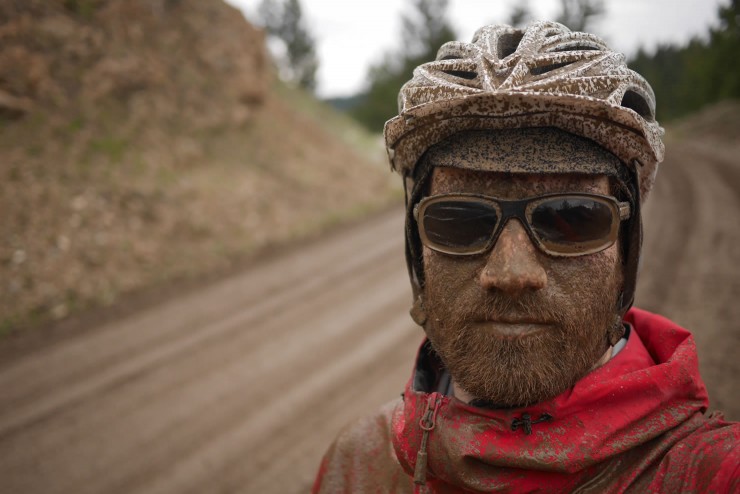
Rider’s Background
When not on some longer exploratory bikepacking trip, I tend to do my riding on a mountain bike on the steep, technical trails of southwestern British Columbia. Earlier this year, I spent three months finding new bikepacking routes in Chile’s central Andes. Despite my bias toward lighter loads and harder trails, I’ve put in my time riding on pavement with four panniers, and everything in between. I’ll admit a preference toward standard flat handlebars and more upright riding positions for all but the fastest road riding.
Height 6’2”
Weight 180lbs
Inseam to ground 34.6”
Please keep the conversation civil, constructive, and inclusive, or your comment will be removed.






